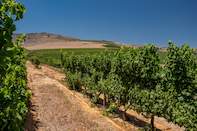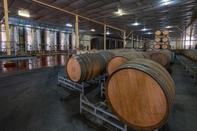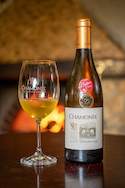In the Vineyard
As there is the majestic Big Five among Africa’s wildlife, so South Africa is proud to have the ‘big five’ of what are considered internationally to be the ‘noble’ or ‘classic’ white wine varieties in its vineyards. Chardonnay is one of them.

The others are chenin blanc, sauvignon blanc, semillon and riesling, though in the South African context the latter has diminished considerably in recent decades and something like muscat de Frontignan also known as muscat blanc might be considered a contender.
They are among the leading varieties upon which South Africa’s fine-wine industry has been building a secure and lasting future in the world wine market.
Chardonnay accounts for what may seem a meagre percentage of the total Vitis vinifera plantings in South Africa, fluctuating between seven and eight per cent. This constitutes between 6 000 and 8 000 hectares. But this places it a steady fourth on the list of most planted white wine grape varieties, just below another world classic, sauvignon blanc. The top two (chenin blanc and colombar) are also planted to sustain South Africa’s large pool of distilling wine for the country’s excellent brandies.
Also bear in mind that its arrival here is relatively recent, compared with centuries of more widely planted chenin blanc, colombar and semillon. By far the most vines are found in some of the historically most important quality wine-growing regions: over 1 000 hectares each in Robertson, Paarl and Stellenbosch, just under that in the Breedekloof (near Worcester) and the burgeoning Swartland.
Chardonnay’s ‘unofficial’ introduction to the Cape is the stuff of anecdotal industry legend. Frustrated by the red tape involved in having new vine material imported, propagated and released to wine growers by the authorities in the 1970s and ‘80s, a band of intrepid, progressive winemakers (they shall remain nameless) with contacts in Europe through wine studies and working trips, started bringing in material, tucked away in their suitcase, hidden about their person.
It backfired somewhat, when what was thought to be chardonnay turned out to be auxerrois, or auxerrois blanc, of which chardonnay is regarded a relative in its home country Alsace. The mistake was subsequently rectified with official importation of the right stuff from France, with the late Sydney Back, pioneer from third-generation family farm Backsberg, among the first to produce the real thing.
Chardonnay was long thought to be from the pinot family, which counts both white and red varieties among its members. It may have been because of its proliferation in Burgundy in partnership with the equally classic red pinot noir, also synonymous with that region. The two share a near-identical leaf shape – this being a good trick in identifying varieties in the vineyard, especially when berry size and shades of greens and reds begin to become difficult to distinguish.
Chardonnay is now regarded as being a major vine variety in its own right, and an ancient one at that, with white muscat generally agreed to be its ancestor. In fact, one of its clones has a distinct muscat overtone (different clones of each grape variety bringing a different aroma and flavour profile to the juice it produces and often blended by winemakers for greater complexity in a single wine).
Grapes grown in cool-climate coastal or mountain areas (Walker Bay’s Hemel en Aarde Valley, Elgin and Constantia) make it easier for winemakers to produce chardonnays of pedigree. Chardonnay planted on mountain foothills and higher-lying ground in warmer areas (Stellenbosch, Paarl, Franschhoek) where altitude and breezes create cooler conditions also produce quality wines.
Through experience, growers and winemakers have found that chardonnay does well in stony, clay-rich, shale-derived soils, whether in cool, coastal or mountainous climes or warmer, drier inland areas such as Robertson. Pockets of chardonnay also found rooted in limestone soils here, also known to benefit the variety, are producing outstanding wines.
In the Cellar

South African chardonnay’s swings in style and quality have been settling down in recent decades as winemakers became more adept at drawing out the best from this responsive, malleable grape. They have found a workhorse with a fine pedigree, able to add body to their white blends, make easy-drinking wine to please most palates or try to achieve greatness.
The variety produces quite a neutral wine if made as an unembellished dry white. What it always has, however, is natural body; what feels like a weightiness in the mouth. But fermenting and/or maturing chardonnay in oak barrels allows this classic variety to show yet another side of its multi-faceted personality: longevity. Unlike many other white wines, generally best enjoyed while young and fresh, a wooded chardonnay has remarkable bottle aging potential. But this is only if the balance between its many parts is right: full-ripe grapes, lively acid and delicate, smooth oak.
As vines have matured, new clones imported and plantings extended across the length and breadth of the winelands, familiarity has developed with how the variety performs in different terroirs and different kinds of oak barrels (from size to degree of toasting to forest, region and country of origin). Having initially merely matured chardonnay in small mostly French oak barriques, winemakers also began fermenting the juice in barrel, invariably producing a softer, more integrated wood-influenced wine. Further dictated by increasingly discerning local consumer tastes, and competing internationally with the world’s best for appreciation by a sophisticated wine market, South African chardonnays of greater complexity, subtlety and charm are being turned out.
The heavily wooded versions of the late 1900s, matured in brand new, small barrels by winemakers familiar with France’s classic White Burgundy but still exploring where to plant and how to make a South African equivalent, resulted in mostly heavyweight wines with strong toasty oak and rich vanillin flavours. These initially impressed local wine lovers with their easily distinguishable characteristics, despite the wines being ‘challenging’ to enjoy as an everyday tipple. These typically New World blockbusters eventually led to the so-called ‘ABC’ request from consumers: ‘Please, anything but chardonnay!’ But this has changed over the past couple of decades. South African chardonnays, in a range of styles, offer appealing wines of excellent quality which should not be ignored.
Whether it’s the variety’s neutrality, body or response to oak, chardonnay is brilliant for blending. It is teamed with any number of one of more of the other white varieties in South Africa’s vineyards, from sauvignon blanc to semillon, chenin blanc to colombar, riesling to roussanne, viognier to verdelho. These are wines in a growing category of white blends, usually with an element of oaking, that provide easy drinking but with a certain amount of character and complexity not previously found in the ubiquitous white blends of some decades ago.
More importantly, chardonnay is either the sole ingredient or an integral part of a blend that constitute South Africa’s growing line-up of commendable champagne-style wines. It is one of the classic Champagne grapes (together with red varieties pinot noir and pinot meunier) and provides strength, finesse, freshness and longevity to these premium bottled-fermented bubblies made in the traditional méthode Champenoise. South Africa’s faithful renditions are officially known as méthode Cap Classique (MCC) or simply cap classiques. (By law only wines from the French region of Champagne may be called champagne).
In the Glass

Typical aromas and flavours found in a chardonnay: citrus (lemon, lime), marmalade, tropical fruit (melon, pineapple), butter, butterscotch, toffee, caramel, honey, spice (cloves, cinnamon), toast, nuts (almonds).
As easy as it is to make and enjoy a 'nice' ordinary chardonnay, this variety needs wood to show its real depth of character. The naturally lemon-yellow white wine then assumes the lustre of burnished gold. Fermentation and/or maturation in oak barrels turns simple lemon or lime aromas and flavours into a marmalade melange; natural smoothness into creaminess; nuttiness into buttered toast.
The oak imparts vanillins, infuses with spice (cloves, cinnamon) and carries the flavours and textures of caramel, toffee and butterscotch. Wood can make a ripe, fruity young wine last a good few years, becoming honeyed with age. This is never more so than with a fine chardonnay.
For wine lovers, the variety’s versatility offers a range of styles without necessarily compromising quality. Unwooded Cape chardonnays can charm with a lemony freshness on top of that natural body. There are a number of acclaimed chardonnay producers that offer lovely unwooded examples (Jordan, Glenelly, Springfield).
Distinctive clonal characteristics are particularly recognisable in chardonnay. One clone teases tropical fruit, another is redolent of nuts. The oak element via barrel fermentation or maturation adds butteriness and spiciness. For an exercise in different styles, explore the extensive range from long-term chardonnay specialist De Wetshof in Robertson, or the chardonnays grown in stony soils (Springfield) compared with a rare pocket of limestone (one of Richard Kershaw Wines’ highly rated renditions of this grape).
Within the ‘serious’ category of chardonnay you will find two predominant styles. The elegant wines emphasise the typical lemony freshness, with delicate oak flavours lending just a hint of creaminess and toastiness. The richer, more full-bodied wines combine ripe citrus fruit flavours with a butteriness and toastiness from the barrel.
Experienced names, specialist producers and consistently decorated wines include pioneers of the premium cool-climate Hemel en Aarde valley, Hamilton Russell and Bouchard Finlayson. Among the exciting new generation is Newton Johnson, Restless River, Creation and La Vierge. In Elgin there is Richard Kershaw, Paul Cluver and Oak Valley among others. Most of Constantia’s vineyards and winemakers produce fine chardonnays, including Groot Constantia and Buitenverwachting.
Look out for Stellenbosch stars, from established Jordan, Warwick and Hartenberg to emerging high-profile producers DeMorgenzon, Delaire Graff and Glenelly. In Paarl there is established name Glen Carlou and in Franschhoek exciting Leeu Passant. Overall, South African winemakers now know what it takes to make good chardonnay, whether for undemanding every-day drinking or with the complexity and stature to satisfy the connoisseur.
With a Meal
Food recommendations generally differ for the two different styles of South African chardonnay. Full-bodied chardonnays go well with dishes that feature sauces made with cream, cheese or nuts.
While red wines are generally favoured with meats, chardonnay is a white wine with the body and structure to go well with lighter, more delicate red or white meats such as veal, poultry and rabbit, as well as meaty fish such as tuna and rich seafood such as the local delicacy perlemoen (abalone). Medium-bodied chardonnay is an ideal wine accompaniment to Parma ham, smoked salmon, patés, terrines and creamy cheeses.